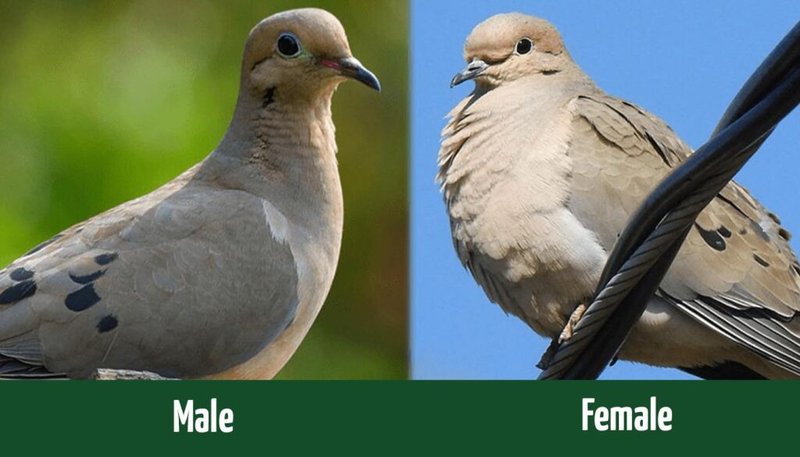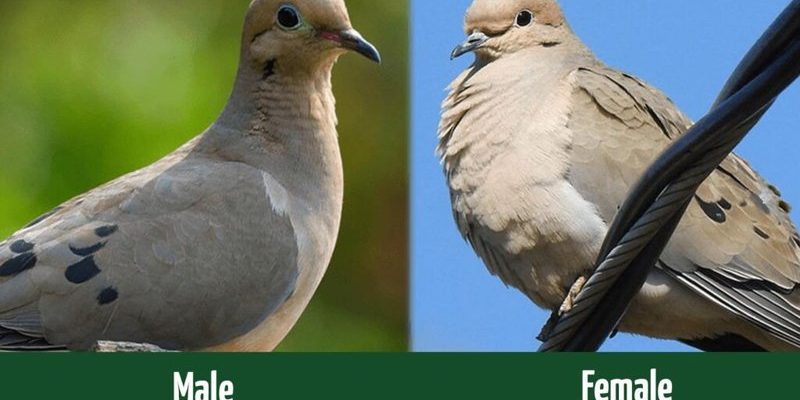
Mourning doves are fascinating creatures, and figuring out how to spot them can be both fun and rewarding. With their graceful flight and subtle colors, they can sometimes be mistaken for other birds—so knowing what to look for is key. In this guide, I’ll help you get familiar with these lovely birds, from their distinct markings to their preferred habitats, so you’ll feel ready to identify them in the wild.
Physical Characteristics of Mourning Doves
When it comes to identifying mourning doves, their physical characteristics are a great place to start. First off, these birds have a distinct shape: they’re slender and long-tailed, which gives them a streamlined look. Their plumage is mostly a soft grayish-brown, but if you look closely, you’ll notice subtle hints of pink and orange on their wings and breast. This coloration allows them to blend in well with their environment, making them a bit tricky to spot sometimes.
Additionally, mourning doves have a unique black spot on their wings and a slightly rounded tail with white edges, which is a wonderful way to differentiate them from other similar-looking birds. If you catch a glimpse of one in flight, the tail feathers often fan out, revealing those stunning white tips. Isn’t it amazing how such small details can make all the difference in identification?
Finally, the size of mourning doves is something to note. They’re relatively small birds, measuring about 9 to 13 inches in length, with a wingspan of approximately 17 to 18 inches. Think of them as the smaller, more delicate relatives of pigeons—their graceful movements are a sight to behold.
Listening for Their Distinct Calls
A big part of identifying mourning doves is their vocalizations. You might be wondering, “What do they actually sound like?” Mourning doves have a soft, melodious cooing call that’s often described as sounding like “coo-COO-coo.” This call is especially prevalent during the breeding season, and if you listen closely, you might hear it echoing through backyards or parks.
Interestingly, the sound is a way for them to communicate not just with each other, but also to establish territory. When you hear that call, it’s a gentle reminder that these birds are nearby. It can also help you locate them, as you may find them perched on wires or trees, enjoying the sunny weather while they coo softly away.
If you’re trying to really dial into their calls, consider taking a moment to sit still in nature. The quieter you are, the more likely you are to hear their soft cooing, which can lead you right to where they’re hanging out. It’s like tuning into the natural symphony around you, where mourning doves play their gentle part.
Habitat Preferences of Mourning Doves
Understanding where mourning doves like to hang out can significantly boost your chances of spotting them. These birds are highly adaptable and can thrive in various environments, from rural areas to urban settings. You’ll often find them around open fields, parks, and even backyards. They enjoy areas where they can find food and have a clear view of their surroundings.
One of the key factors is the availability of food. Mourning doves primarily eat seeds, which they can readily find in gardens, along roadsides, and in fields. They’re often seen foraging on the ground, scratching around to uncover tasty seeds. If you want to attract them to your yard, consider planting bird-friendly flowers or simply leaving some seed on the ground—they’ll be drawn in for a meal.
Mourning doves also appreciate places to perch, such as trees, power lines, and fences. When spending time outdoors, keep an eye out for them lounging in these spots. They tend to be most active during dawn and dusk, so those are prime times for sightings. Picture this: you’re enjoying a warm morning coffee, and through the window, you spot a mourning dove perched contentedly, just starting its day.
Behavioral Traits of Mourning Doves
When you’re out spotting mourning doves, their behavior can offer valuable clues for identification. These birds typically exhibit calm and gentle behaviors, often seen foraging or preening in pairs. Unlike some birds that are easily startled, mourning doves tend to be relatively tame and can sometimes let you get quite close before they take flight.
One interesting behavior is their characteristic “bob and weave” movement. When they walk or forage, they often bob their heads slightly as they move. This can be a key observation point when you’re trying to identify them in a group of birds. Think about it like they’re giving a little dance as they search for food!
During the breeding season, you might see pairs performing courtship displays, which can include wing flapping and circling around each other. Watching this can be an adorable reminder of nature’s rhythms and patterns. Plus, when you see these behaviors, you know you’re in the presence of mourning doves!
Seasonal Considerations for Spotting Mourning Doves
Mourning doves can be spotted year-round in many places, but their behavior and presence can shift with the seasons. In the spring and summer, they’re typically more visible as they establish their nests and raise their young. You might spot them more frequently around feeders or open areas, where they can hunt for seeds.
As fall approaches, they often gather in larger flocks to feed and migrate to warmer areas. If you’re out in late summer or early fall, keep an eye on the skies for groups of mourning doves flying together. It’s a captivating sight, watching them move in unison like a wave across the sky.
In winter, they may still be present in their preferred habitats but can become a bit more elusive as they seek shelter from the cold. If you’re in a region where winters are harsh, you might have to look a little harder to find them. During warmer months, though, they’re busy raising their young and can be seen more actively foraging for food early in the morning or late in the evening.
How to Use Binoculars for Birdwatching
If you want to take your mourning dove spotting to the next level, using binoculars can enhance your experience. With a decent pair of binoculars in hand, you can observe these charming birds from a distance without disturbing them. Here’s how to get started.
First, choose binoculars that are comfortable for you. A good starting point is a pair with an 8x magnification and a 42mm objective lens. This gives you a nice balance between magnification and field of view—perfect for birdwatching. Make sure they’re lightweight so you can carry them around easily.
When you spot a mourning dove, hold your binoculars steady to get a clear view. If you’re having difficulty focusing, adjust the center knob until the image is sharp. Don’t forget to take note of the surrounding environment, as this can help you become more skilled at spotting them in various situations. You might find that using binoculars opens up a whole new world of birdwatching!
Final Thoughts on Identifying Mourning Doves
Learning how to identify a mourning dove in the wild is a rewarding experience. Whether it’s their soft calls or their graceful form, these birds add a touch of beauty to our daily lives. By paying attention to their physical features, behaviors, and preferred habitats, you’ll soon find yourself spotting them with ease.
So next time you’re outside, take a moment to listen and look a little closer. You never know when you might catch sight of a mourning dove, quietly cooing and filling the air with its sweet sounds. Birdwatching can deepen your connection to nature and remind you of the simple joys all around us. Enjoy the adventure!

